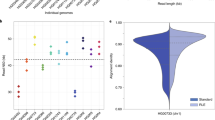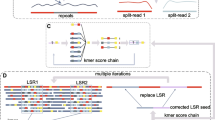Abstract
Galaxy is a web browser-based data analysis platform that is widely used in biology. Public Galaxy instances allow the analysis of data and interpretation of results without requiring software installation. NanoGalaxy is a public Galaxy instance with tools and workflows for nanopore data analysis. This chapter describes the steps involved in performing genome assembly using short and long reads in NanoGalaxy.
Access this chapter
Tax calculation will be finalised at checkout
Purchases are for personal use only
Similar content being viewed by others
References
Payne A, Holmes N, Rakyan V, Loose M (2018) BulkVis: a graphical viewer for Oxford nanopore bulk FAST5 files. Bioinformatics 35:2193–2198. https://doi.org/10.1093/bioinformatics/bty841
Amarasinghe SL, Su S, Dong X et al (2020) Opportunities and challenges in long-read sequencing data analysis. Genome Biol 21. https://doi.org/10.1186/s13059-020-1935-5
Afgan E, Baker D, Batut B et al (2018) The Galaxy platform for accessible, reproducible and collaborative biomedical analyses: 2018 update. Nucleic Acids Res 46:W537–W544. https://doi.org/10.1093/nar/gky379
de Koning W, Miladi M, Hiltemann S et al (2020) NanoGalaxy: nanopore long-read sequencing data analysis in Galaxy. GigaScience 9. https://doi.org/10.1093/gigascience/giaa105
Tyson JR, O’Neil NJ, Jain M et al (2017) MinION-based long-read sequencing and assembly extends the Caenorhabditis elegans reference genome. Genome Res 28:266–274. https://doi.org/10.1101/gr.221184.117
Galaxy Europe. https://usegalaxy.eu/. Accessed 18 May 2022
European Galaxy Flavours. https://galaxyproject.eu/posts/2020/12/28/subdomains/. Accessed 18 May 2022
Syme A, Soranzo N (2022) A short introduction to Galaxy (Galaxy training materials). https://training.galaxyproject.org/training-material/topics/introduction/tutorials/galaxy-intro-short/tutorial.html. Accessed 18 May 2022
Batut B, Hiltemann S, Bagnacani A et al (2018) Community-driven data analysis training for biology. Cell Syst 6:752–758.e1. https://doi.org/10.1016/j.cels.2018.05.012
De Coster W, D’Hert S, Schultz DT et al (2018) NanoPack: visualizing and processing long-read sequencing data. Bioinformatics 34:2666–2669. https://doi.org/10.1093/bioinformatics/bty149
Filtlong: quality filtering tool for long reads. https://github.com/rrwick/Filtlong. Accessed 18 May 2022
Kolmogorov M, Yuan J, Lin Y, Pevzner PA (2019) Assembly of long, error-prone reads using repeat graphs. Nat Biotechnol 37:540–546. https://doi.org/10.1038/s41587-019-0072-8
Chen S, Zhou Y, Chen Y, Gu J (2018) fastp: an ultra-fast all-in-one FASTQ preprocessor. Bioinformatics 34:i884–i890. https://doi.org/10.1093/bioinformatics/bty560
Vasimuddin Md, Misra S, Li H, Aluru S (2019) Efficient architecture-aware acceleration of BWA-MEM for multicore systems. In: 2019 IEEE International Parallel and Distributed Processing Symposium (IPDPS). https://doi.org/10.1109/IPDPS.2019.00041
Okonechnikov K, Conesa A, García-Alcalde F (2015) Qualimap 2: advanced multi-sample quality control for high-throughput sequencing data. Bioinformatics btv566. https://doi.org/10.1093/bioinformatics/btv566
Walker BJ, Abeel T, Shea T et al (2014) Pilon: an integrated tool for comprehensive microbial variant detection and genome assembly improvement. PLoS One 9:e112963. https://doi.org/10.1371/journal.pone.0112963
Kyran A (2021) Fasta statistics: display summary statistics for a fasta file. https://github.com/galaxyproject/tools-iuc. Accessed 18 May 2022
Sutton JM, Millwood JD, Case McCormack A, Fierst JL (2021) Optimizing experimental design for genome sequencing and assembly with Oxford Nanopore Technologies. Gigabyte 2021:1–26. https://doi.org/10.46471/gigabyte.27
Wick RR, Schultz MB, Zobel J, Holt KE (2015) Bandage: interactive visualization ofde novogenome assemblies: Fig. 1. Bioinformatics 31:3350–3352. https://doi.org/10.1093/bioinformatics/btv383
Pilon: Methods of Operation. https://github.com/broadinstitute/pilon/wiki/Methods-of-Operation. Accessed 18 May 2022
Mikheenko A, Prjibelski A, Saveliev V et al (2018) Versatile genome assembly evaluation with QUAST-LG. Bioinformatics 34:i142–i150. https://doi.org/10.1093/bioinformatics/bty266
Manni M, Berkeley MR, Seppey M et al (2021) BUSCO update: novel and streamlined workflows along with broader and deeper phylogenetic coverage for scoring of eukaryotic, prokaryotic, and viral genomes. Mol Biol Evol 38:4647–4654. https://doi.org/10.1093/molbev/msab199
Acknowledgments
The authors would like to thank all members of the valuable scientific communities: the Pitagora Network (https://pitagora-network.org) and Galaxy Project (https://galaxyproject.org/). The authors also acknowledge the support of the Freiburg Galaxy Team: Björn Grüning, Bioinformatics, University of Freiburg (Germany), funded by the Collaborative Research Centre 992 Medical Epigenetics (DFG grant SFB 992/1 2012), and the German Federal Ministry of Education and Research BMBF grant 031 A538A de.NBI-RBC.
Author information
Authors and Affiliations
Corresponding author
Editor information
Editors and Affiliations
Rights and permissions
Copyright information
© 2023 The Author(s), under exclusive license to Springer Science+Business Media, LLC, part of Springer Nature
About this protocol
Cite this protocol
Ohta, T., Shiwa, Y. (2023). Hybrid Genome Assembly of Short and Long Reads in Galaxy. In: Arakawa, K. (eds) Nanopore Sequencing. Methods in Molecular Biology, vol 2632. Humana, New York, NY. https://doi.org/10.1007/978-1-0716-2996-3_2
Download citation
DOI: https://doi.org/10.1007/978-1-0716-2996-3_2
Published:
Publisher Name: Humana, New York, NY
Print ISBN: 978-1-0716-2995-6
Online ISBN: 978-1-0716-2996-3
eBook Packages: Springer Protocols




